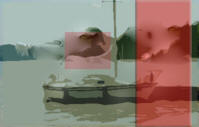|
Cloth--a
whole strip of canvas
Head--the
top of a sail
Leech--the
side of a sail
Luff--the
weather leech, or the side first touched by the wind
Foot--the
bottom or lower edge
Clew--the
two lower corners
Tack--the
rope attached to the foremost lowest corner of a course
Sheets--the
ropes that spread the lower corners (except on a course), and the after
lower corners of a course
Bunt--the
middle cloths
Boltrope--the
rope sewed around the edges of a sail
Cringle--a
strand of rope worked round and into the boltrope for the reef earrings,
bowline bridles, and reef tackle pendants
Robands--pieces
of sennit plaited round the head rope of the sail, for securing it to
the jackstay on the yard
Head earrings--ropes
spliced into the head cringles to secure them to the yardarms
Reef earrings--ropes
used in combination with points or beckets to secure the sail to the
yard when reefs are taken in
Tabling--the
double part of a sail, close to the boltrope
Eyelet holes--holes
formed in the tabling and reef bands for the robands, reef lines,
buntline toggles, and cringles
Bowline bridles--used
to flatten the surface of a sail when it is set
Buntlines--ropes
attached to the leeches of topsails and courses; used in reefing and
bending
Clewlines--ropes
attached to the clews of all square sails; used when taking them in
Buntline cloth--double
part of a sail to take the chafe of the buntline
Reef tackle patch--double
part to take the strain of the reef tackle
Reef bands--double
part across a sail for working the eyelet holes for the reef lines or
points in each reef
Belly band--double
part across a topsail below the fourth reef for strength
Top lining--double
part on the after side of a topsail to take the chafe of the top
Goring cloth--any
cloth cut obliquely
Roach--the
curve in the foot of a sail
Slab--any
slack part of a sail hanging down |




![]()